One of the things I was taking pictures of in Paris were large-scale wall murals, because for a long time, I’ve been planning to push for large-scale art on Dayton buildings. However, I was thinking ad space as well as mural space. Apparently, we’ve had a turnaround on this in City Hall- but more on this in a bit.
A few walls that I’d love to see adorned- the back of CareSource- it’s a huge beige blank wall- that can be seen easily heading up Jefferson toward Riverscape and the huge blank wall facing the back of the Cannery on Wayne Avenue (building is owned by Montgomery Paper), The side of the Convention Center on Jefferson facing the Transportation Center garage (during an Urban Nights- someone was projecting performance art on it), the side of Aquarius nightclub, the backside of the building Dayton History was in- facing Riverscape, the wall that used to have the huge American Flag facing WorkFlow One. Other spaces include the current graffiti location along the railroad trestle behind the Second Street Market and not to be left out- I’d have painted one on my office building (which probably used to have a huge ad on it when it was an old corner grocery store). (If you’d like more information about the mural at right- here is the artist’s website: https://www.jefaerosol.com/ )
Of course, having a big blank wall facing a major street can also be a source of revenue for property owners like the little consignment shop on Brown/Warren at Oak- or the side of the new Coco’s building on Warren- which could have ads on them. Another is a building owned by Gary Goldflies on Wayne right next to Eastway. These walls could hold electronic billboards, giant ad murals- that could help pay for the maintenance of their buildings. But, for some reason, propaganda via paint scares our city fathers- and they want to have some kind of legal rule (and ability to charge for your right of free speech on the side of your private property).
Unfortunately, I barely have a sign on my building- because I didn’t feel like fighting the city any more than I already had to just to revitalize a building that had been vacant for twenty years. My workaround was to mount a piece of glass inside the storefront window- that originally was sandblasted with our name and address- but now just has a vinyl logo- on it- because they have no jurisdiction on what is in the window- but do with what is ON the window)
Despite a nasty fight with Key Ads for the “Dayton Feature” electronic billboard on US 35, which the mayor was against, (also see my post Electronic Billboards and You) somehow we seem to have made a turnaround:
A 40-foot-tall dancer, a two-story-high composer, and a 90-foot-long Wright brothers scene are among the images soon expected to grace Dayton buildings, as three large murals have recently been approved by city officials, and other projects are in the works.
Two of the murals will celebrate Dayton’s arts scene, with one already under way downtown at East Third and St. Clair streets, across from the Dayton Metro Library main branch. Dayton also added colored accent lighting to new bridges and to the parking garage at Fifth and Jefferson.
The arts murals could soon be joined by other images, as Dayton this fall expanded its “graphics overlay district” downtown, which permits large “wallscapes” and special electronic signs.
“I think it can give downtown the look of cities like New York and Tokyo,” Dayton Mayor Gary Leitzell said. “Most world-class cities have great public displays of art, and this is our opportunity to show we’re a world-class city.” (emphasis added)
The idea for the arts murals, which feature performers from groups such as Dayton Ballet, Human Race Theatre Company and Dayton Philharmonic, took shape very quickly.
“It happened in about two days on Facebook,” said Richard Kaiser, a local marketing strategist and arts supporter who is behind those projects. (Note: Richard is a member of UpDayton, and works for ad agency “The Ohlman Group– he’s the kind of guy we need pushing this city forward, and he’s also from Celina, just like me).
Kaiser said after an artist friend posted a picture of a New Orleans wall mural, he asked his friends if anyone knew of a good Dayton site. Kaiser said he quickly got in touch with Brian West, president of Dayton Park-n-Go, which owns two multistory buildings with blank walls, and the idea was off and running.
Kaiser said the DPL Foundation provided financial support, and city officials and the Downtown Dayton Partnership were enthusiastic. Local artist Josh Flohre, of Color Logistik Group, will install the arts-related murals at 133 E. Third St. and 20 N. Jefferson St., with a mix of his own work and images from photographer Andy Snow.
“The one building was kind of run-down and the wall looked bad, so the main thing is to beautify the city and inspire people,” Flohre said.
The City Plan Board has also approved a 98-foot by 12-foot mural of the Wright brothers and Wright-B Flyer for the upper side of a building at 506 Wayne Ave., and Wright-Dunbar Inc. is applying for city approval of a 12-foot-high Paul Laurence Dunbar mural promoting literacy at 1137 W. Third St.
Graphics district
Murals have long been allowed in Dayton if the applicant gets “conditional use” from the city. But the expanded “graphics overlay district” this year brings new abilities to do high-impact signs on the sides of buildings, even renting space on buildings the advertiser doesn’t own.
Dayton city planner Tony Kroeger said that could include anything from wall-size photo advertising — like the several-stories-tall LeBron James Nike ad that graced a Cleveland building for years — to digital billboards. Kroeger and Leitzell both mentioned that Key-Ads, an existing Dayton sign company, hopes to move downtown to Third and Jefferson and install major electronic signs and creative lighting.
“The point was to allow those where they make sense,” Kroeger said, adding those types of signs still have to be approved by the Plan Board. “If you currently have a blank wall that adds nothing, why not?”
Columbus model
Kroeger said Dayton’s policy was inspired by downtown Columbus, where “advertising murals” and large digital signs have been in use for seven years. Some of those wall ads are dramatic, such as a Nationwide Children’s Hospital ad with children appearing to climb and swing between wings of a building.
Dan Williamson, spokesman for Columbus Mayor Michael Coleman, said the city got fairly little opposition from residents, most of whom Williamson said like having a livelier, noisier, more active downtown.
“One issue Columbus grappled with was the idea that downtown was a place people worked, and then they went home to their neighborhoods, and Mayor Coleman really wanted to change that,” Williamson said. “There are some people who don’t like the big ads, but this is what a city looks like, this is what a downtown looks like.”
Columbus’ urban design manager, Daniel Thomas, said the city was sued, unsuccessfully, by the Ohio Department of Transportation, which argued that ad murals along state and federal roads violated a highway beautification act.
Now Columbus’ downtown commission requires murals to meet certain standards on use of art, size of text and interaction with architecture.
“The biggest problem is the creep of advertising, as a lot of these things are becoming more and more commercial,” Thomas said. “The (commission) points to better ones, often done by nonprofit groups, and says, ‘Why don’t you do this?’ But the client wants something else.”
Dayton philosophy
Kroeger said Dayton is trying to encourage designs and concepts “different from the everyday billboard” to add visual interest and a sense of vibrancy to downtown.
“I saw a quote at the onset of the Great Recession saying the next big thing might not be a big thing; it might be a thousand little things,” Kroeger said. “Signage and lighting can be a lower investment, but higher impact.”
Kroeger and Kristen Wicker of the Downtown Dayton Partnership both mentioned public art and more vibrant streets as important to making downtown “more walkable” and a place people want to be. Wicker said the murals are another success of downtown’s Activated Spaces program, which has put art in vacant storefronts.
“Yes, we’re permitting things that in the past, we wouldn’t,” Kroeger said. “It’s a little different, but that’s not necessarily a bad thing.”
In Paris, the way the city originally funded the Velib bike-share system was by granting a single contract to an outdoor ad company- to manage all outdoor ad spaces (bus shelters, billboards etc.) in exchange for the bike system.
In the last 25 years there has been one man quietly painting large scale murals and ads in town, somehow managing to work around our draconian zoning folks- Jim Gagnet of Pacesetter Painting and co-owner of Coco’s. He’s the one responsible for putting the paint on the Oregon bridge/gate way, the Neon Movies exterior, the Coco’s sign, the murals on the side of his building facing U.S. 35 E at the Keowee exit at the corner of Hickory in South Park- and just recently painting the side of Theresa Gasper’s Full Circle Development building facing Clover off Wayne.
There are very few true sign painters left unfortunately. New on-demand large format printing tools make it easy to print huge banners on vinyl, canvas and other materials- including vinyl with pinholes so people inside can see out if applied to glass- while people on the outside only see the art. Gagnet still knows how to grid and scale art- and then paint art on walls by hand.
There are many opportunities in Dayton to change the color and tone of our town. Garden Station and UpDayton did a beautiful job putting art underneath the train overpass on Wayne (could use better lighting at night- and we still could paint the outside of the trestle. too). Unfortunately, RTA killed off full bus wraps and practically killed the ads on the sides of buses which was easy revenue for them. I love this taxi wrap I saw in London- it’s a cell phone ad.
We’ve also seen a little bit of light go a long way on the new bridges and the Transportation Center garage.
It’s time to let loose Dayton- let the people paint, light, poster, play on the canvas of our community. We need places for wall posters, graffiti, ads, art, color- that are unregulated and untaxed. It’s also time to realize that everything doesn’t have to be a free ride for the arts- or connected to the Wright Brothers when it comes to outdoor art.
- Possibly by Banksy? Street art on Paris alley
- Why not let your logo live large?
- Outdoor out of control- and it’s still fun!
- Think Big- in NYC the boards have to be bigger to match the scale of the city
I’ve got a whole collection of photos of large scale art and ads from my travels. To me, art does make the city come alive- from the smallest graffiti like the one at left at the entrance to an alley on the Left Bank in Paris (which might be by the artist Banksy) to the billboards of Times Square. This is a no-cost way of livening up Dayton- that could happen almost overnight – if we let go of the reins.
And of course, there is my favorite billboard, that used to have a full sized Mini-Cooper on the side of a Columbus building- with my mantra for all to see:
What do you think?

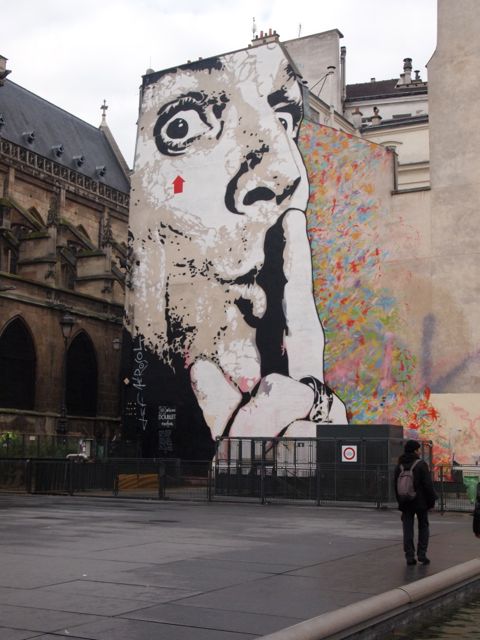

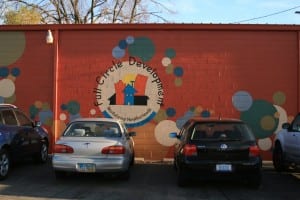
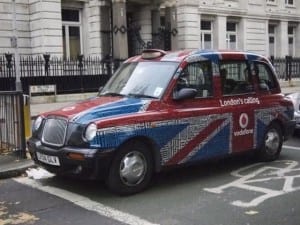
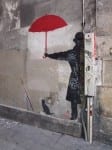
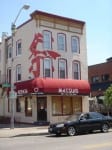

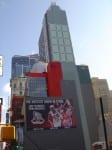
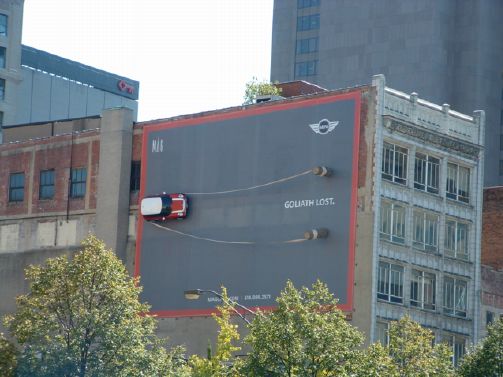
I love it. Not so fond of billboards within a city, but I do love to see wall murals as either advertising or art, but often on the side of a building, it becomes both at the same time. Requarth Lumber has a lovely one, and there is an old advertisement on the side of a building in downtown Tipp, the product escapes me now, but it’s quite charming. Billboards distract from the architecture of a building, and we have such beautiful buildings here I don’t want to see that happen but murals can highlight the unique characteristics of a building, and often age with the building in lovely and remarkable ways.
We also have abandoned buildings and houses that we could turn those over to artists, even if temporarily. We have plenty of talent here, time to show it off!
They should put up a print of a Robert Pollard collage. They did this in Liverpool, England about 5 years ago. Dayton’s finest artistic export.
http://popzeuscomic.blogspot.com/2006/09/robert-pollard-collage-in-liverpool.html
Now the question remains, will the City of Dayton let the spirit of human creativity loose to scale heights of creative greatness, or will we be treated to large paintings of McRibs and the vanilla art preferences of the corporate class as is per the routine?
Lipstick on a pig.
Well, I don’t think Dayton is entirely porcine, but I can think of a couple of dozen deep problems that run to the fundamental and practical, rather than the whimsical and aesthetic.
So long as public money isn’t being spent, it boils down to free expression. You should be allowed to paint your building any way you please, barring only blatantly offensive or sexual images.
Love the murals – advertising or otherwise – although I do feel slightly concerned about more electronic billboards going up downtown. I live in St Clair Lofts and the one currently over by White Lotus/Miami Jacobs drowns out most everything else with the light it produces. Still, well light streets make people feel safer – so I guess I don’t feel that strongly against it.
The graphics and signs can add a lot to the “urban” experience and bring vitality to the area.
The City of Columbus has what I believe to be a good cut at standards – and addresses specifically the issue of “dynamic signs” – the ones that look like Jumbotrons and can be dangerously distracting for drivers, and ugly for their neighbors, and contributors to light pollution generally.
Note that their code has exceptions for historic districts and etc. which make a great deal of sense to me. The code (in, I believe, a non-ADA compliant PDF!) can be found here http://goo.gl/SWdXF
Dayton would do well to spend some time at looking at what other communities have done with signage and art. There’s a huge bunch of work already done – and starting from scratch is a poor way to begin this kind of design study. So yeah, what’s up in Paris, London, and Paducah KY just for starters?
Great stuff, David! Thanks.
There was a sign painter here who did signs for Dafflers Pharmacy and Midnight Market. I recall those when I first moved here, as being pretty good. Dont know what happened to that painter or what his story was, but he was doing sort of an old-school retro style of sign painting.
Then we have those old ghost signs, like Boscul and the Sachs Pruden ale sign on a corner store in St Annes Hill.
But yeah…as usual David you are on-target with these comments. Hmmm..even a reference to bansky. Has anyone else in Dayton beside you and I heard heard of him? That stencil style he uses could be a quick way to get street art up.
But we are talking more elaborate stuff, as you show in yr illustrations.
And, here is an interesting graphic showing how they jazzed up the L in Chicagos Plisen neighborhood…painted steps at the L station:
http://www.bing.com/images/search?q=Chicago+murals+Pilsen&view=detail&id=46269C1B7623CB3138ECFE26EB59908B886D4E08&first=91&FORM=IDFRIR
Not to mention an entire gallery of murals and street art from one Chicago neighborhood…Pilsen:
http://www.bing.com/images/search?q=Chicago+murals+Pilsen&qpvt=Chicago+murals+Pilsen&FORM=IGRE#x0y2404
Louisville has that local promo campaign with huge building size posters of famous Louisvillians….
>Lipstick on a pig.
>a reference to bansky. Has anyone else in Dayton beside you and I heard heard of him? [sic]
Sheesh…
I remember quite a battle between Whittman Bike and the city back in the early ’90s whether or not the mural on the side of their building could contain advertising. Outcome I think was art was fine with no text. Unless the ordnance has changed our mayor might be well advised to check the laws before endorsing projects.
Gosh, J, I’ll bet nobody in Ohio but you and David have3 ever heard of Banksy.
Yeah, I mean Banksy was only the subject of an Academy Award nominated film – you’d have to live in a reeeeeally hip mega-metropolis to know about him. Or, you know… have a Netflix account.